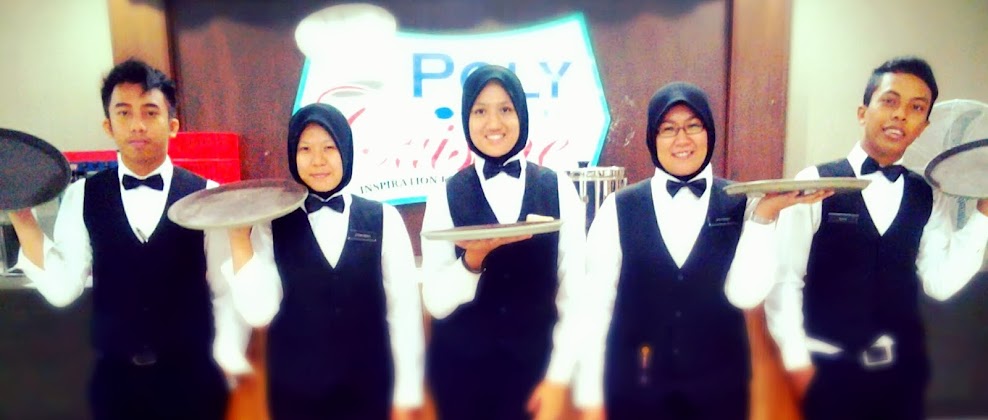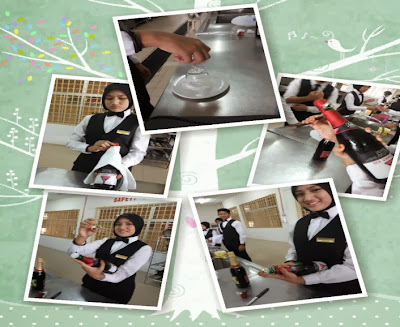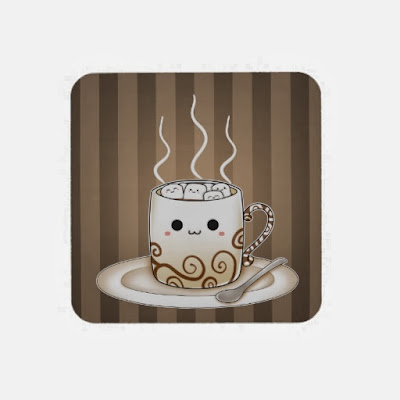OPeNInG SpARkLINg BOttELS AnD WaTeR CaNs.
Hye guys,Assalamualaikum and salam sejahtera.We meet again here in this blog ^_^.....
Today our group will update how want to opening bottles and water cans. Actually we learn about how to open wine bottle. But, we replace the wine water to sparkling water, because there was look same right?
As a server in a restaurant, it is important to push wine sales because it will increase the total amount of the bill, and it's an easy way to get an entire table to have a drink. Knowing how to properly present a bottle of wine will make you look more professional and will leave a good impression on your guests.
There are many devices and types of equipment that have been invented to help staff or personnel in the beverage service. In order to carry out efficiently the service of all forms of drink requested, the bar should have all the necessary equipment available for making cocktails, decanting wine, serving wine correctly, and making fruit cups.
beverage service equipment and usage:
 |
| (ice bucket) |
>For chilling bottles of white wine, champagne, roses and sparkling wines.
 |
| (Wine opener) |
>Used for opening bottles of wine. Includes corkscrew, blade, bottle opener and lever. Known as “Waiter’s friend”
 |
| (decanter) |
>Bottles of very old vintage red wine are slowly poured into a decanter, leaving any sendiment behind the bottle
 |
| (Service cloth) |
>Chilled wines (which are taken from an ice bucket) may be held in a folded service cloth during pouring to prevent drops from falling.
...........Here we show you step how to opening this bottle and water cans...........
.
STEP TO OPENING SPARKLING BOTTLE.
1. Chill the bottle well prior to opening. A bottle that is not properly chilled will push the cork out on its own and will foam up and out of the bottle aggressively, making a mess and wasting wine
2. Locate a dish, bar, or serving towel. Use it to dry off the bottle, if wet from being chilled.
3. Grasp the neck of the bottle with four fingers of your left hand (if right-handed) and place your thumb over the top of the basket.
4. Twist the retaining wire on the wire cage six half-turns counter-clockwise. The cork may be pushed out by the pressure any time after the basket is loosened, so apply firm pressure with your thumb on the top of the basket. If your wine was adequately chilled, the cork will rarely if ever get pushed out on its own.
5. Either leaving the wine cage on the cork or removing it, put your thumb on top of the cork and grasp it with the rest of your hand. While holding the cork steady, firmly twist the bottle with your right hand. It is most comfortable to do this with the bottle held at a 45 degree angle and balanced on your side or hip.
6. If you do not feel the cork loosening, pull with increasing pressure on the cork with your left hand while still rotating the bottle with your right hand.
7. When the cork starts to come out, slow its exit with your left thumb, allowing it to barely pop out.
8. The goal of this operation is to barely make a sound when the cork comes out.
9. Pour the wine into clean Champagne flutes.
STEP TO OPENING WATER CANS

1. prepare the equipment for serve the water can. Example like a straw, ice, rock glass, waiter cloth and also water cans.
2. Pour the ice into the glass.
3. Examine the top of can to see if it is dirty. If it is, wipe any dirt or debris from the can, especially near the mouth.
4. Put your finger under the tab on top of the can.
5. Lift up slowly but firmly so you get it open but don't get the fizz everywhere (If can has been shaken and in carbonated do not open for 15 min).
6. Listen for the *sts* sound as it opens, and then continue to lift up until open all the way.
7. Push tab back down all the way so as to keep it from getting in your way as you drink.
8. Then, pouring the drink into the glass with a manner.
It makes a new experience to us when we try it. It is something
new and we love to learn it after see Madam Asmahani make a demonstration.
so, keep this challenge to try opening sparkling bottle and can!!
DO THE BEST!










.jpg)































.jpg)



.jpg)
.jpg)



